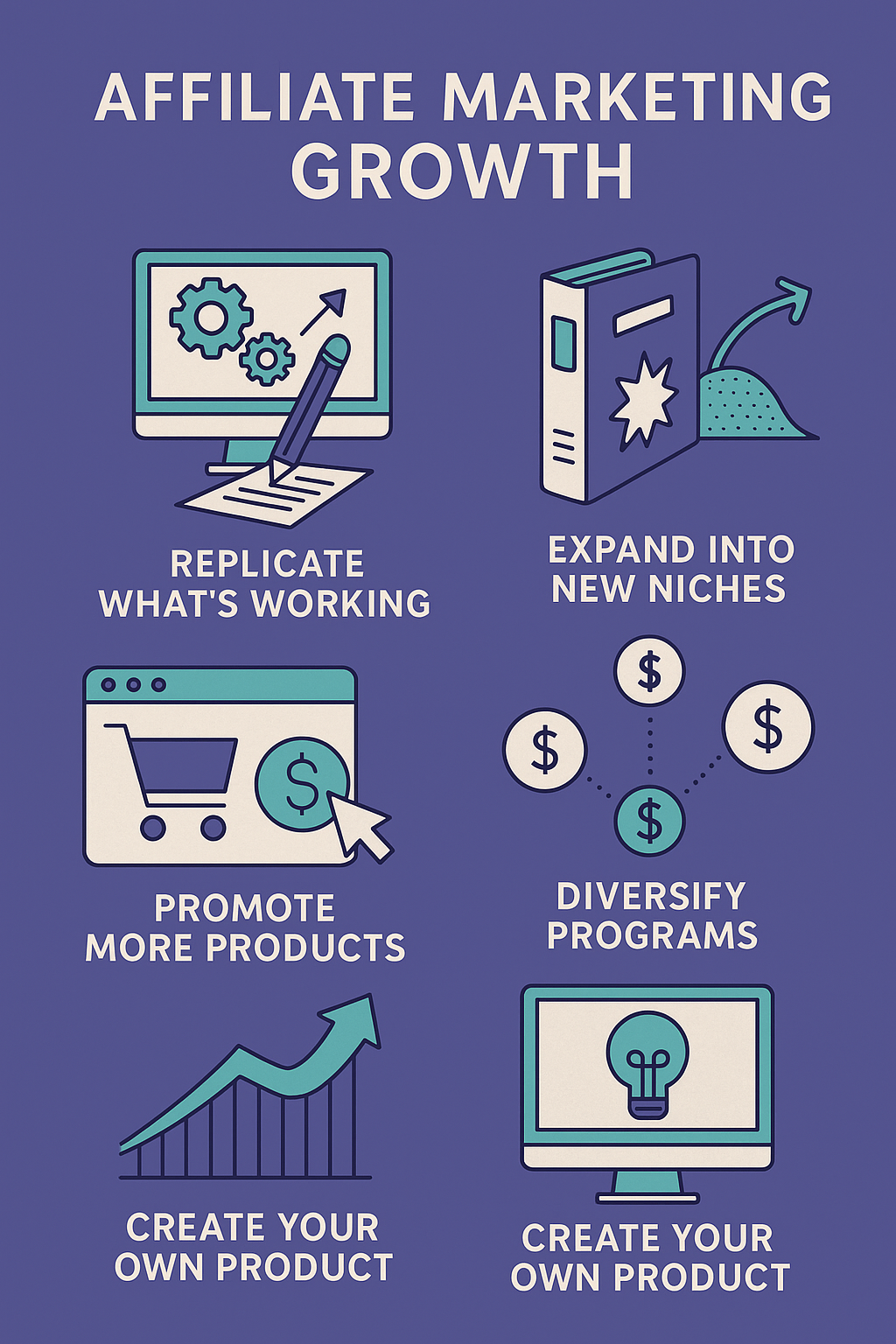Once you’ve mastered the basics of affiliate marketing — choosing a niche, setting up your first site, creating content, and earning that first commission — a natural question arises:
“What’s next?”
This is where the real growth begins.
You’ll hear people say things like “wash, rinse, repeat.” But what does that actually look like in a modern affiliate strategy? How do you scale intentionally — without burning out or wasting time on tactics that don’t move the needle?
Let’s break it down.
1. Duplicate What’s Working — But Smarter
Scaling affiliate income doesn’t mean blindly repeating every step. It means identifying what’s working, why it’s working, and then replicating the process with improved precision.
Here’s how:
-
Audit your current content: Which affiliate pages are getting traffic and conversions?
-
Spot the pattern: Are you ranking for a certain type of keyword (like “best [product] for moms”)? Are certain formats (videos, reviews, tutorials) doing better than others?
-
Clone and improve: Once you know what works, apply that strategy to new sub-niches or products — with upgraded design, better calls-to-action, or more strategic linking.
2. Expand Into Parallel or Complementary Niches
Instead of jumping into a completely different industry, consider branching out in a related direction. For example:
If you’re crushing it in the baby gear niche:
-
Add sub-sites like baby monitors, nursery decor, or toddler meal kits.
-
Then build a hub site — say, “SmartParentingHQ.com” — that links to all these sub-niches. This improves SEO and gives visitors a reason to explore more of your content.
If you’re in fitness:
-
Expand into niches like home gym equipment, supplements, or yoga gear.
-
Create guides like “The Ultimate Home Workout Setup (With Affiliate Links)” to cross-promote.
This kind of niche stacking builds brand authority and boosts your overall earnings potential.
3. Test Markets Without Building Full Sites
You no longer need to build an entire site to test a niche.
Instead, use platforms like:
-
Medium or LinkedIn Articles
-
YouTube (short review or “best of” videos)
-
Quora (strategic answers with soft affiliate links or links to your site)
-
Substack (start a mini newsletter before you launch a full site)
These platforms allow you to test content, keyword viability, and product-market fit before investing time and money into a new niche site.
4. Promote a Broader Range of Products
One of the easiest ways to scale? Promote more — but strategically.
-
Start with clustered niches (e.g., a blog about camping gear could also promote backpacks, tents, survival tools, and hiking boots).
-
Use content hubs and internal linking to keep readers on your site and expose them to more offers.
-
Track conversions to see what’s resonating — then double down.
Pro tip: Use tools like ThirstyAffiliates or Pretty Links to manage and track your affiliate links.
5. Diversify Affiliate Programs for Higher Earnings
Don’t get stuck with a single network.
If you’re only using Amazon:
-
Add ShareASale for niche product brands
-
Try CJ Affiliate for big-name retailers
-
Explore ClickBank, WarriorPlus, and JVZoo for high-commission digital products
If you’re in digital marketing or business niches, platforms like Impact and PartnerStack are also worth exploring.
Different affiliate networks offer:
-
Better commission rates
-
Unique products not listed elsewhere
-
Faster or more reliable payouts
6. Level Up Your Traffic Strategy
More content won’t help if no one sees it. Here’s how to grow traffic strategically:
-
SEO: Use keyword research tools like Ubersuggest, Surfer SEO, or Ahrefs.
-
Pinterest: Great for niches like DIY, food, parenting, and fashion.
-
YouTube: Repurpose blog content into videos and include affiliate links.
-
Email marketing: Build a list from day one using a lead magnet like a checklist or mini guide.
Your list becomes a long-term asset you can promote to again and again — not just once.
7. Become a Product Creator (The Next-Level Move)
Eventually, the biggest leap in affiliate growth happens when you create your own product.
Here’s how to bridge the gap:
-
Package your knowledge into a mini-course, ebook, or paid newsletter.
-
Inside your product, include affiliate links to the tools or services you recommend (like autoresponders, page builders, or niche-specific software).
-
Promote it via email, blog posts, or social media.
Example: A blog about blogging could create a course on “How to Start a Niche Site” and include affiliate links for hosting, themes, and keyword tools.
Not only do you earn from the product, but you continue earning from the embedded affiliate links. It’s the ultimate win-win.
Final Thought: Growth Doesn’t Mean Hustling Harder — It Means Scaling Smarter
Affiliate marketing isn’t just about doing more — it’s about doing what already works better and more strategically. Test, optimize, duplicate. Expand into related niches. Diversify your offers. And build systems that bring traffic and trust to your content.
Whether you’re aiming for $1K/month or six figures a year, sustainable affiliate growth is all about layering small wins into big momentum.


Leave a Reply